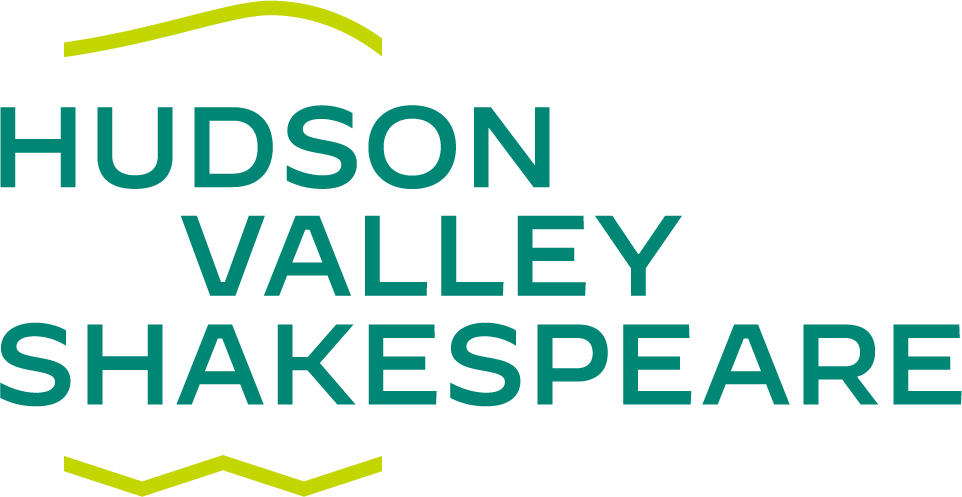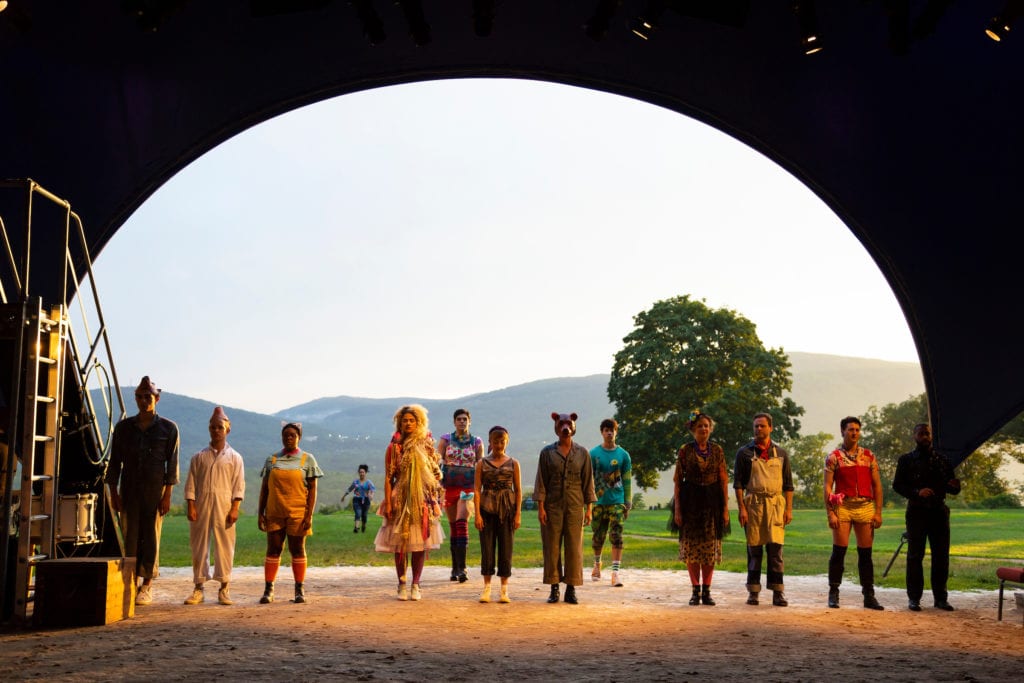Posted August 6, 2020
What was the secret sauce that made last summer’s production so wonderful? Our Artistic Director, Davis McCallum, caught up with WOODS Director Jenn Thompson, Costume Designer Sara Jean Tosetti, Choreographer Rhett Guter, and Musical Director Amanda Morton to reflect on the process of creating HVSF’s first-ever musical. Relive the magic with us.
For Jenn, how did you convene this group? And what kind of work did you do before you even got to the first rehearsal?
Jenn: At the beginning, Davis asked if I wanted to do it. I think I said “yes” before he even got out the word “woods”! I knew it was coming. And I immediately thought of both Rhett and Amanda as those key collaborators, in terms of choreography and musical director. I had worked with Amanda the summer before on a musical and just fell in love with her, not just her talent, but her spirit. I had a strong hunch it was going to require an “all in” type of personality to climb into that tent and take that on, and I knew she had not just the talent, but the right attitude.
Rhett and I have worked together a number of times, though never in this capacity. He’d always been a key actor in the company, and a great collaborator. Working on choreography together, was something we had always talked about wanting to do as another step in our collaboration.
With Sara Jean in terms of costume design, that was a recommendation from Davis. We met at a coffee shop between our two homes in Brooklyn. And I knew within five minutes that she was my gal. You can tell, it’s tribal — who you want to be in the room with, or in this case, the tent with. And that was how it started.
The 2019 INTO THE WOODS company during the performance’s prologue.
It seems like everything that could have been a limitation, became a provocation for creativity — I’m thinking of that amazing moment where Nance Williamson switched from being the Stepmother to being Jack’s Mother. That was a directing, music directing, choreography, costume challenge. All four of you worked together to solve that switcheroo, and it was crystal clear, it was surprising, and it allowed the thing to go forward.
Jenn: Well we knew we had to get that right in the beginning because it’s a lot to follow anyway, even in a regular theater scenario. Lots of words, lots of different things going on. We knew that if we didn’t establish what the story was and how we were going to tell it, and teach the audience right off the bat, this is how you’re going to listen, this is where you should be looking, that it would be a fail. There was a lot riding on the prologue.
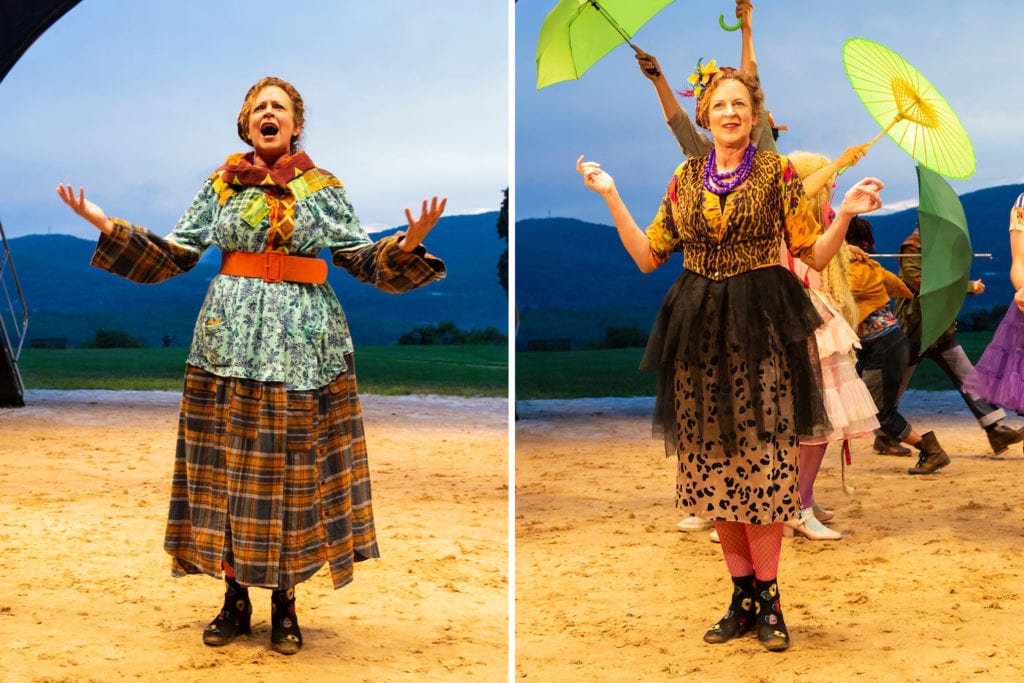
Nance Williamson as Jack’s Mother and Cinderella’s Stepmother in INTO THE WOODS.
Sara, do you want to talk about how you plugged into Jenn’s vision? Or how you got started on your work?
Sara: My first meeting with Jenn, we talked about everything but INTO THE WOODS. We realized that we were both intense feminists in theater, and had a lot of common views on things. Without even talking about the play too much, we jumped into looking at images. It came out very organically, how we wanted to do a modern take on the fairy tale, and figure out what are the stories that we are telling, especially to young women. I had not seen an INTO THE WOODS that was helmed by such a strong female director. Jenn had this idea to really empower Little Red and empower Cinderella in a strong way. And that the Baker’s Wife, isn’t just a wife. From the beginning, these are independent characters that are then having an experience. And then how do you represent that visually? For me, you’ll notice that they’re all in pants. That was my costume nerd way of translating that idea.
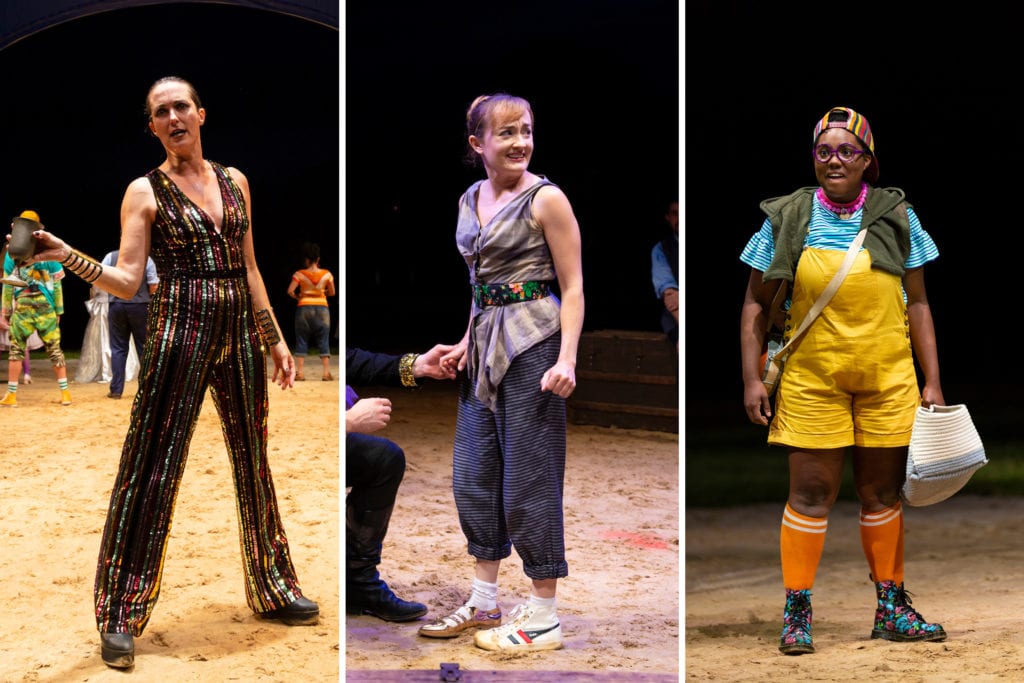
Leenya Rideout as the Witch, Laura Derrell as Cinderella, and Kayla Coleman as Little Red.
Then for me specifically, because I had worked at the tent before, I knew that the environment at HVSF is another character. It’s not really the set, it’s really another character, with its own moods and with its own opinions that are changeable. It’s not just like a set that you play against. It’s another being that you respond to and have to know how to deal with. So for me, color becomes really important, to get people to pop out of that really beautiful landscape and to focus the audiences’ attention.
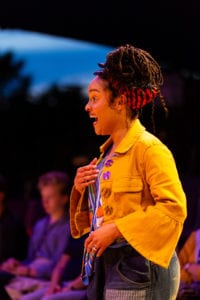
Then there are all the technical things that work in the rehearsal hall, don’t work in the tent. And you don’t know until you are in the tent. You need to have plans A through D that work for everything, for pants, for shoes, for all these ideas that you’re like, well we want them to do this fantastic movement, but in these shoes and this outfit they can’t do it so how do we adjust. Then it’s really just a collaboration between what’s more important, the look or how they walk, and then Rhett and I battle it out and Jenn gets to decide. [laughter from all three]
But I think we were all really collaborative. I remember even though on the first day, we had insisted on having fittings all day and then you guys really needed them for music rehearsal. I remember us saying, yeah that’s fine we’ll get them later. Just being in that room where everyone was appreciative of everybody’s work, was really important. Because then you don’t feel like you have to fight to be heard, because you know we’re all here to do a common goal.
Rhett, it’s not a musical that people think of as a real dance musical, but movement is so important to it. And you elided the non-dance movement with the dance movement so artfully. I so admired the precision you brought to this, and you were also in the cast. What was it like to be one of the soldiers in the infantry and also part of Jenn’s creative team?
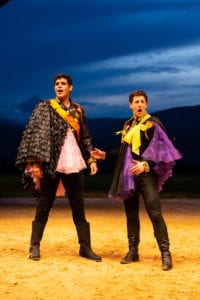
Rhett: It was very challenging. [laughs] It was really interesting, and I’ve talked to Jenn about this since — I have been in and choreographed several musicals that are far more dancey. INTO THE WOODS was by far the hardest challenge I’ve ever had wearing both of those hats. Even though it wasn’t as dancey as something like West Side Story or The Music Man, where I’ve double dutied like that before, it was so intricate. It ended up being this machine, and if one person dropped the ball, the pieces fell apart. And quite honestly, I was the last one to learn the choreography. [all laugh] Because I was trying to see everyone else’s choreography, and it was very challenging.
I have to reiterate what others have already said, the most amazing thing about this production was that we started from a place of “how are we going to do this? — this space is super challenging, we can’t do the proscenium, we can’t use sets, we can’t use lights” Every challenge we had, turned into my favorite parts of the show. In the end, it went from “how are we going to do this show, that was written for a proscenium and written for heavy tech, and written for a big broadway house” it went from that to feeling like “this show was meant to be in this tent and written to be performed this way, with this kind of creativity, without the tech and without the proscenium, and inspiring the imagination.” And is the flip of where I personally went as a creative artist, going “this wasn’t written to be this way” to “this is exactly how this was intended to be done, they’re fools to have done it any other way than this in the past”. It’s kind of remarkable. And that was a testament, of course to Jenn, but to the entire creative team and the collaboration that we’re talking about. It really was all hands on deck for every situation we had to find a creative solution to.
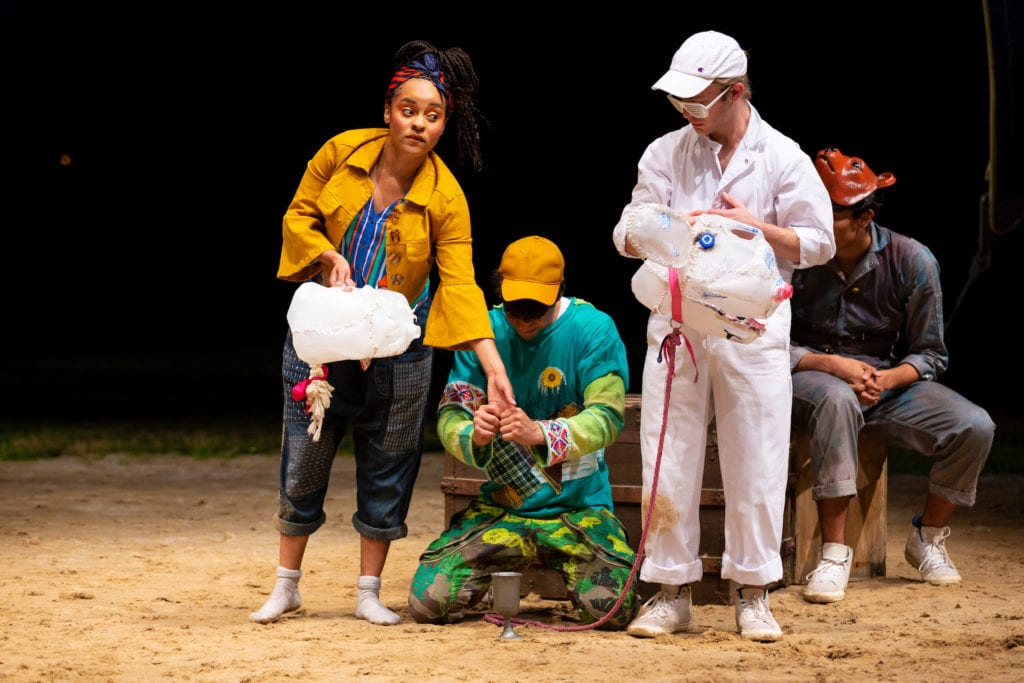
Amanda, they sang it so brilliantly. And that I think for me was the biggest surprise. We handed you some musical theater ringers, but other folks were primarily cast because they were doing a key role in another part of the season. And I thought they lived inside that score so fully and the band sounded so great in that tent. I think that had so much to do with you and your contribution to the show. You had done INTO THE WOODS once previously in Philadelphia, correct?
Amanda: Yeah, I had done a production previously at Theater Horizon in Philly, which was inspired by the Fiasco Theater revival on Broadway which included actor-musos to get at the heart of the folk-like storytelling tradition. In that production, we tailored the instrumental arrangements to what those actors had to offer. And, much like this production, there was a range of backgrounds. We had devisers, musical theater performers, actors who hadn’t done musical theater before. Quickly addressing that range of experience and skill: I actually think that it is the greatest gift because you have internal educational moments within that company of people and everyone is truly committed to asking of themselves to try something new and take a leap of faith. And that’s really hard. And knowing that someone else is also doing something new is often the glue that binds. And then we were all in the tent, which was new and incredible. That kept us “all hands on deck” as other people have said.
With regard to my approach to vocal direction, I often encounter actors and directors who express concern that I may have an expectation to make a show “sound music theater.” They have a notion of how commercial musical theater sound is produced, and what I love about the art for is that it is a really is a huge, diverse body of work. Whenever I hear people reference musical theater as one facet of itself being the perception, I’m eager to defend that it can be anything that ranges from Dreamgirls to The Music Man to Floyd Collins. There are so many opportunities for storytelling. I don’t have a preconceived idea of how people should sound when singing in the musical theater genre. And in fact, the more variation, the more texture, the more alive those ensemble numbers feel, because we’re not trying to sound autotuned – we’re not trying to sound like a cast recording.
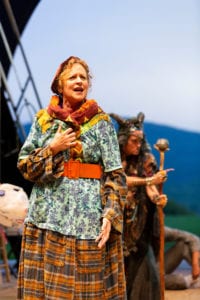
Going back to the transformation moment with Nance Williamson – something that makes her so incredible is that she is someone with incredible speech training and experience, and everything that she’s done as an actor of Shakespeare lends itself so beautifully to being able to make a textural, vocal shift to support what’s going on dramatically and visually. Oftentimes, when I encounter a musical theater singer, and this is definitely not an indictment, they tend to want to play with time. Expression often means that the duration of a phrase is elongated or shortened. How far a singer goes is often intercepted by the composer themselves, the director, and/or music director. Nance is special because she has this delicious obedience to rhythm – which must come from years of doing Hudson Valley Shakes – which puts her brilliantly in the pocket with time and allowed her to prioritize employing textural shifts that lived up to the musical intention of Stephen Sondheim and honored the conceptual intention of Jenn Thompson. And that is so exciting to me! And it’s also required for a piece like this. Everything is happening so quickly, visually, and we have to catch the ear as we tell that story.
Shifting to orchestration, something that Rhett mentioned was calibrating to the space that you are in. With a piece like this, you think about audience members that are incredibly familiar with the original Jonathan Tunick orchestration while balancing the needs of those that are meeting the show for the first time. You want to honor technical elements that are there – themes that Sondheim has stitched together throughout the piece – but also just make it a pleasurable listening experience in general without pointing out how clever we are. For me, I always love strings. I think they are such a vibrant, full instrument. So having the violin and cello with the piano, that’s a little orchestra right there. And then percussion provides you with so much opportunity to fill in character and whimsy and drama. And then I happen to have this percussion player, who happens to be my partner [laughs], who is also a pretty amazing accordion player, so then I didn’t have to forfeit any of the clarinet or saxophone parts because the accordion has a reedy flavor. So you’re able to have the jaunty textures as well as those really lush, romantic, lyrical phrases that make the piece live in our gut. That was really fun!
It was amazing! You could feel the full emotional range of the score with those four musicians. It felt almost miraculous.
All photos by T.Charles Erickson.
